Analyzing HRM Functions, Recruitment, and Employee Relations at HSBC
VerifiedAdded on 2024/05/30
|21
|4231
|495
Report
AI Summary
This report provides a comprehensive analysis of Human Resource Management (HRM) practices at HSBC Bank. It begins by explaining the purpose and functions of HRM, focusing on workforce planning and resourcing, highlighting the importance of identifying employee skills and talent to achieve business objectives. The report then evaluates the strengths and weaknesses of different recruitment and selection approaches, including internal, external, and third-party recruitment methods. It examines the benefits of various HRM practices, such as training and development, for both employers and employees, and assesses the effectiveness of these practices in boosting organizational profit and productivity. Furthermore, the report analyzes the critical role of employee relations in influencing HR decision-making and identifies key elements of employment legislation that impact these decisions. Finally, the report illustrates the application of HRM practices in a work-related context, providing specific examples to demonstrate their practical implementation within HSBC.
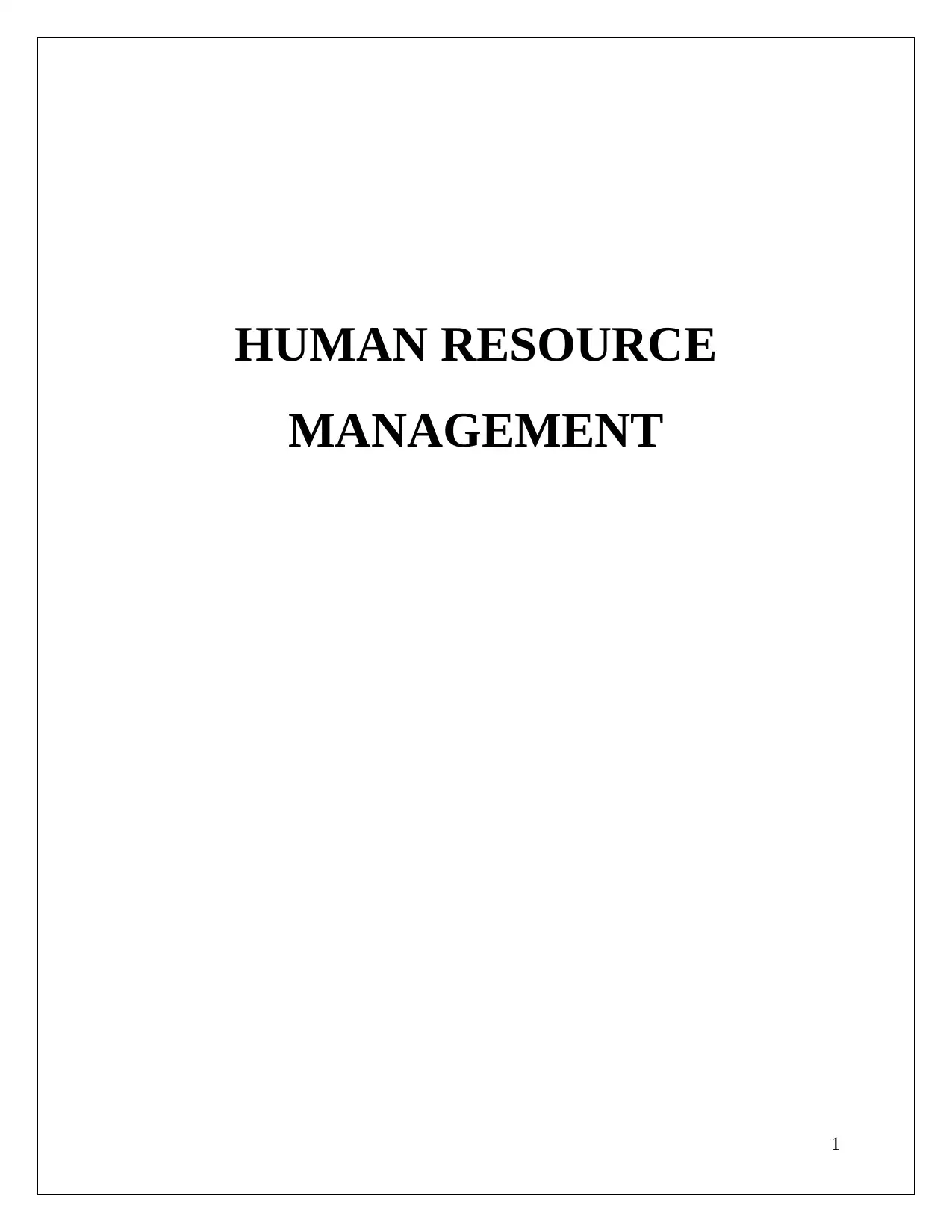
HUMAN RESOURCE
MANAGEMENT
1
MANAGEMENT
1
Paraphrase This Document
Need a fresh take? Get an instant paraphrase of this document with our AI Paraphraser
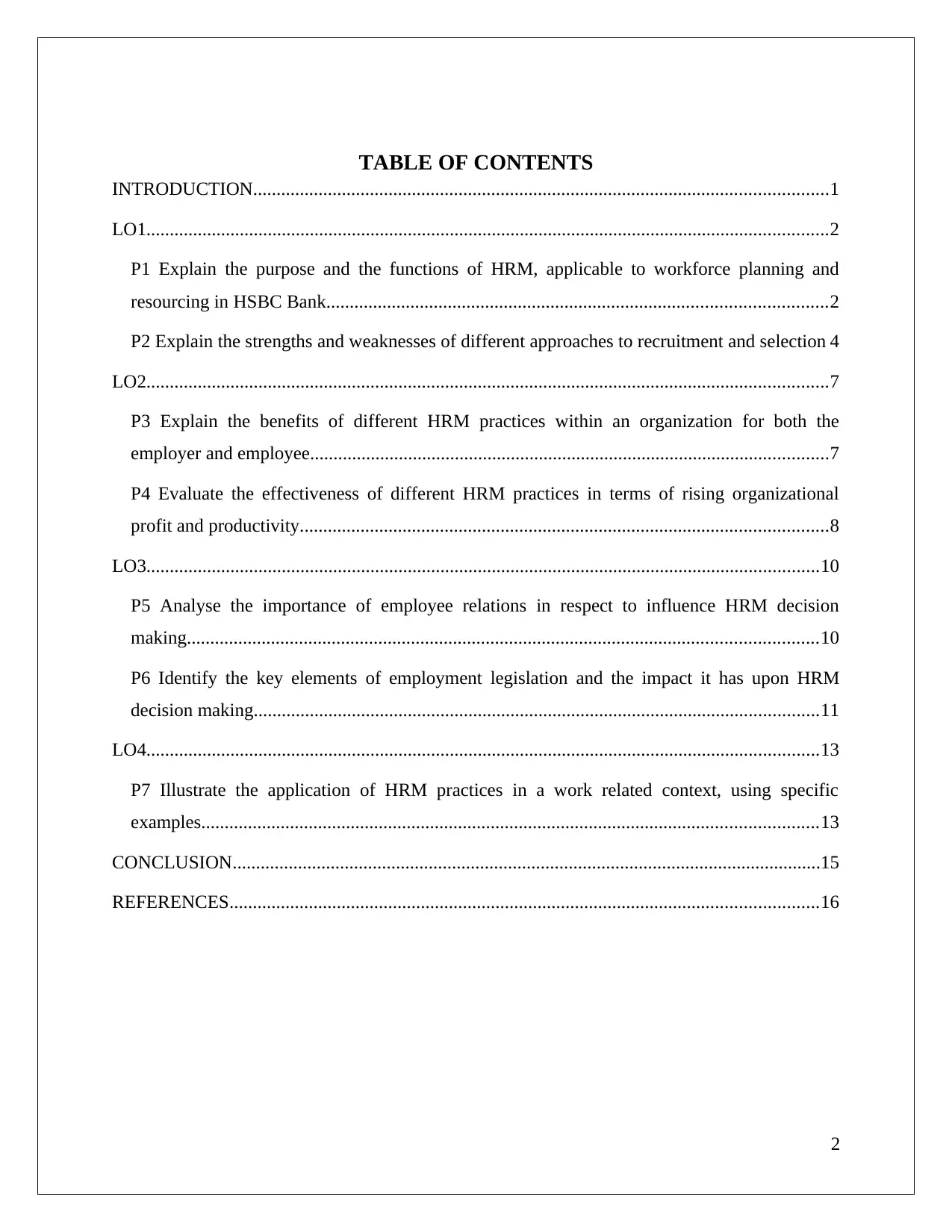
TABLE OF CONTENTS
INTRODUCTION...........................................................................................................................1
LO1..................................................................................................................................................2
P1 Explain the purpose and the functions of HRM, applicable to workforce planning and
resourcing in HSBC Bank...........................................................................................................2
P2 Explain the strengths and weaknesses of different approaches to recruitment and selection 4
LO2..................................................................................................................................................7
P3 Explain the benefits of different HRM practices within an organization for both the
employer and employee...............................................................................................................7
P4 Evaluate the effectiveness of different HRM practices in terms of rising organizational
profit and productivity.................................................................................................................8
LO3................................................................................................................................................10
P5 Analyse the importance of employee relations in respect to influence HRM decision
making.......................................................................................................................................10
P6 Identify the key elements of employment legislation and the impact it has upon HRM
decision making.........................................................................................................................11
LO4................................................................................................................................................13
P7 Illustrate the application of HRM practices in a work related context, using specific
examples....................................................................................................................................13
CONCLUSION..............................................................................................................................15
REFERENCES..............................................................................................................................16
2
INTRODUCTION...........................................................................................................................1
LO1..................................................................................................................................................2
P1 Explain the purpose and the functions of HRM, applicable to workforce planning and
resourcing in HSBC Bank...........................................................................................................2
P2 Explain the strengths and weaknesses of different approaches to recruitment and selection 4
LO2..................................................................................................................................................7
P3 Explain the benefits of different HRM practices within an organization for both the
employer and employee...............................................................................................................7
P4 Evaluate the effectiveness of different HRM practices in terms of rising organizational
profit and productivity.................................................................................................................8
LO3................................................................................................................................................10
P5 Analyse the importance of employee relations in respect to influence HRM decision
making.......................................................................................................................................10
P6 Identify the key elements of employment legislation and the impact it has upon HRM
decision making.........................................................................................................................11
LO4................................................................................................................................................13
P7 Illustrate the application of HRM practices in a work related context, using specific
examples....................................................................................................................................13
CONCLUSION..............................................................................................................................15
REFERENCES..............................................................................................................................16
2
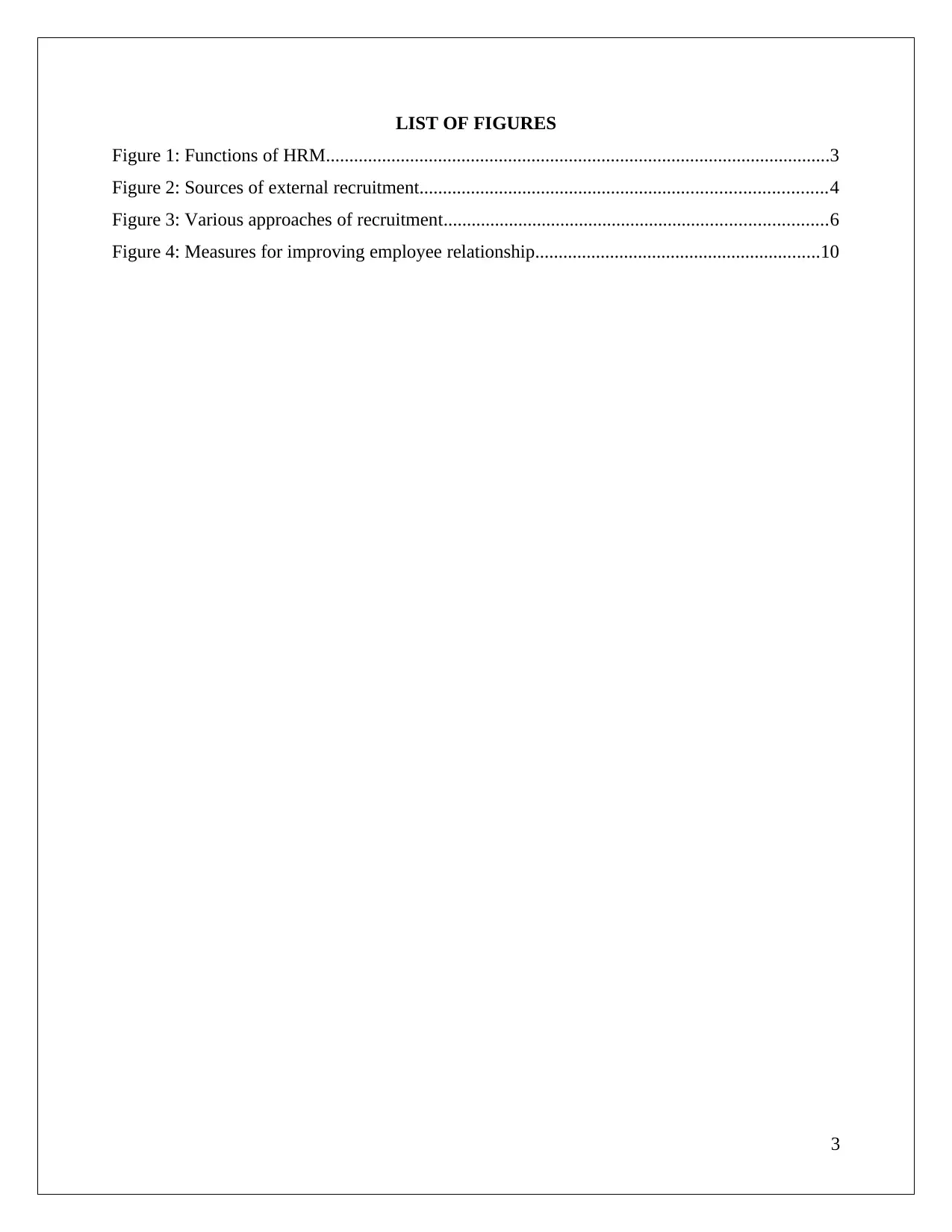
LIST OF FIGURES
Figure 1: Functions of HRM............................................................................................................3
Figure 2: Sources of external recruitment.......................................................................................4
Figure 3: Various approaches of recruitment..................................................................................6
Figure 4: Measures for improving employee relationship.............................................................10
3
Figure 1: Functions of HRM............................................................................................................3
Figure 2: Sources of external recruitment.......................................................................................4
Figure 3: Various approaches of recruitment..................................................................................6
Figure 4: Measures for improving employee relationship.............................................................10
3
⊘ This is a preview!⊘
Do you want full access?
Subscribe today to unlock all pages.

Trusted by 1+ million students worldwide
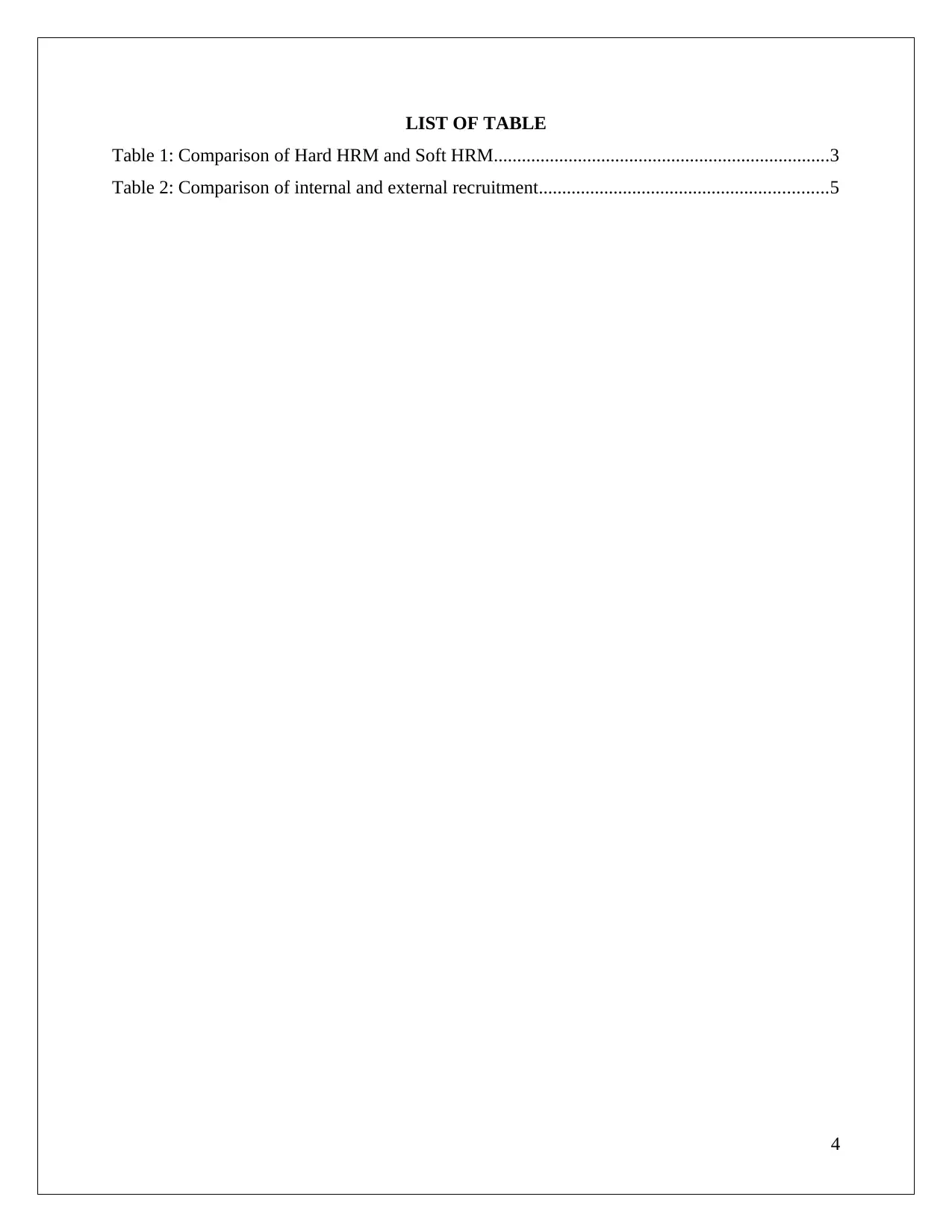
LIST OF TABLE
Table 1: Comparison of Hard HRM and Soft HRM........................................................................3
Table 2: Comparison of internal and external recruitment..............................................................5
4
Table 1: Comparison of Hard HRM and Soft HRM........................................................................3
Table 2: Comparison of internal and external recruitment..............................................................5
4
Paraphrase This Document
Need a fresh take? Get an instant paraphrase of this document with our AI Paraphraser
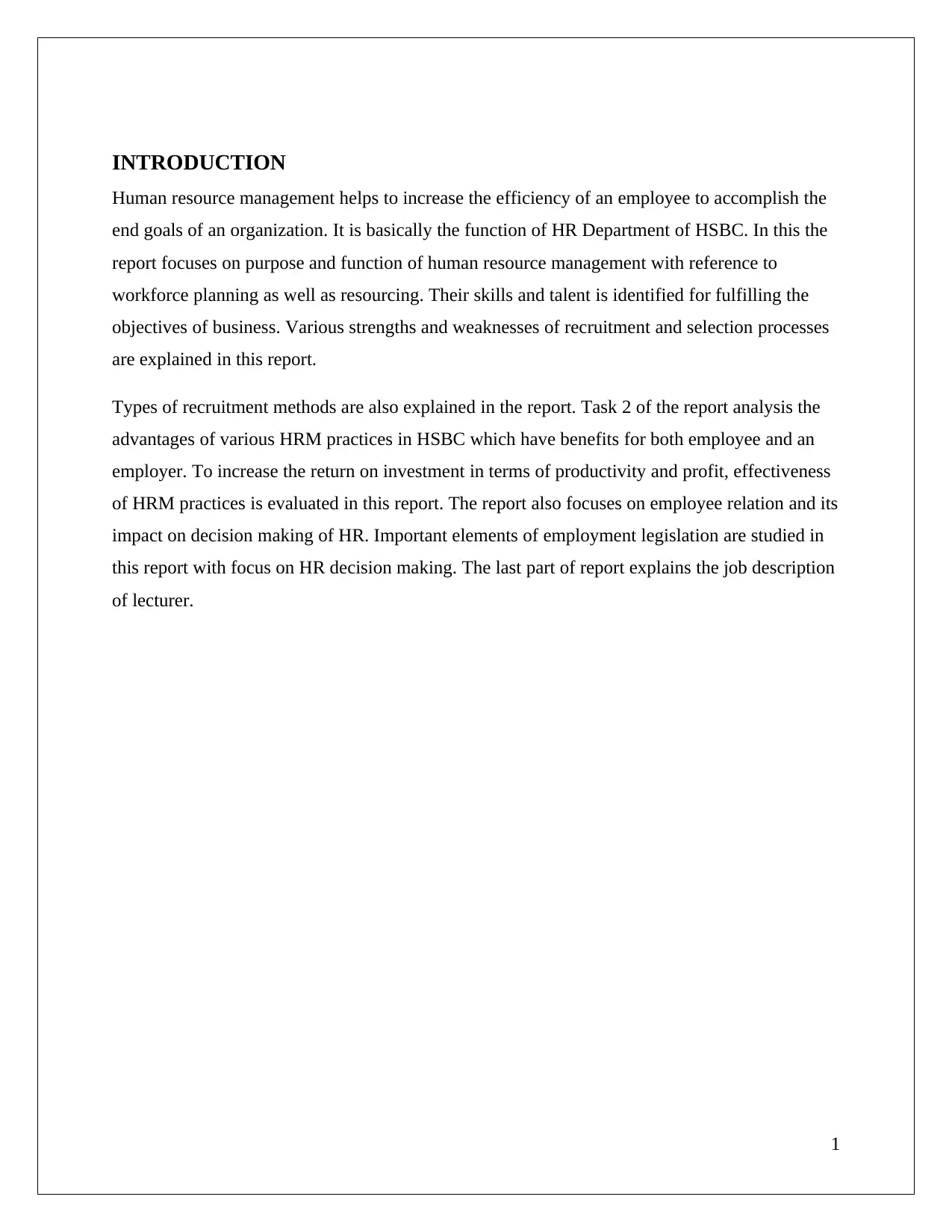
INTRODUCTION
Human resource management helps to increase the efficiency of an employee to accomplish the
end goals of an organization. It is basically the function of HR Department of HSBC. In this the
report focuses on purpose and function of human resource management with reference to
workforce planning as well as resourcing. Their skills and talent is identified for fulfilling the
objectives of business. Various strengths and weaknesses of recruitment and selection processes
are explained in this report.
Types of recruitment methods are also explained in the report. Task 2 of the report analysis the
advantages of various HRM practices in HSBC which have benefits for both employee and an
employer. To increase the return on investment in terms of productivity and profit, effectiveness
of HRM practices is evaluated in this report. The report also focuses on employee relation and its
impact on decision making of HR. Important elements of employment legislation are studied in
this report with focus on HR decision making. The last part of report explains the job description
of lecturer.
1
Human resource management helps to increase the efficiency of an employee to accomplish the
end goals of an organization. It is basically the function of HR Department of HSBC. In this the
report focuses on purpose and function of human resource management with reference to
workforce planning as well as resourcing. Their skills and talent is identified for fulfilling the
objectives of business. Various strengths and weaknesses of recruitment and selection processes
are explained in this report.
Types of recruitment methods are also explained in the report. Task 2 of the report analysis the
advantages of various HRM practices in HSBC which have benefits for both employee and an
employer. To increase the return on investment in terms of productivity and profit, effectiveness
of HRM practices is evaluated in this report. The report also focuses on employee relation and its
impact on decision making of HR. Important elements of employment legislation are studied in
this report with focus on HR decision making. The last part of report explains the job description
of lecturer.
1
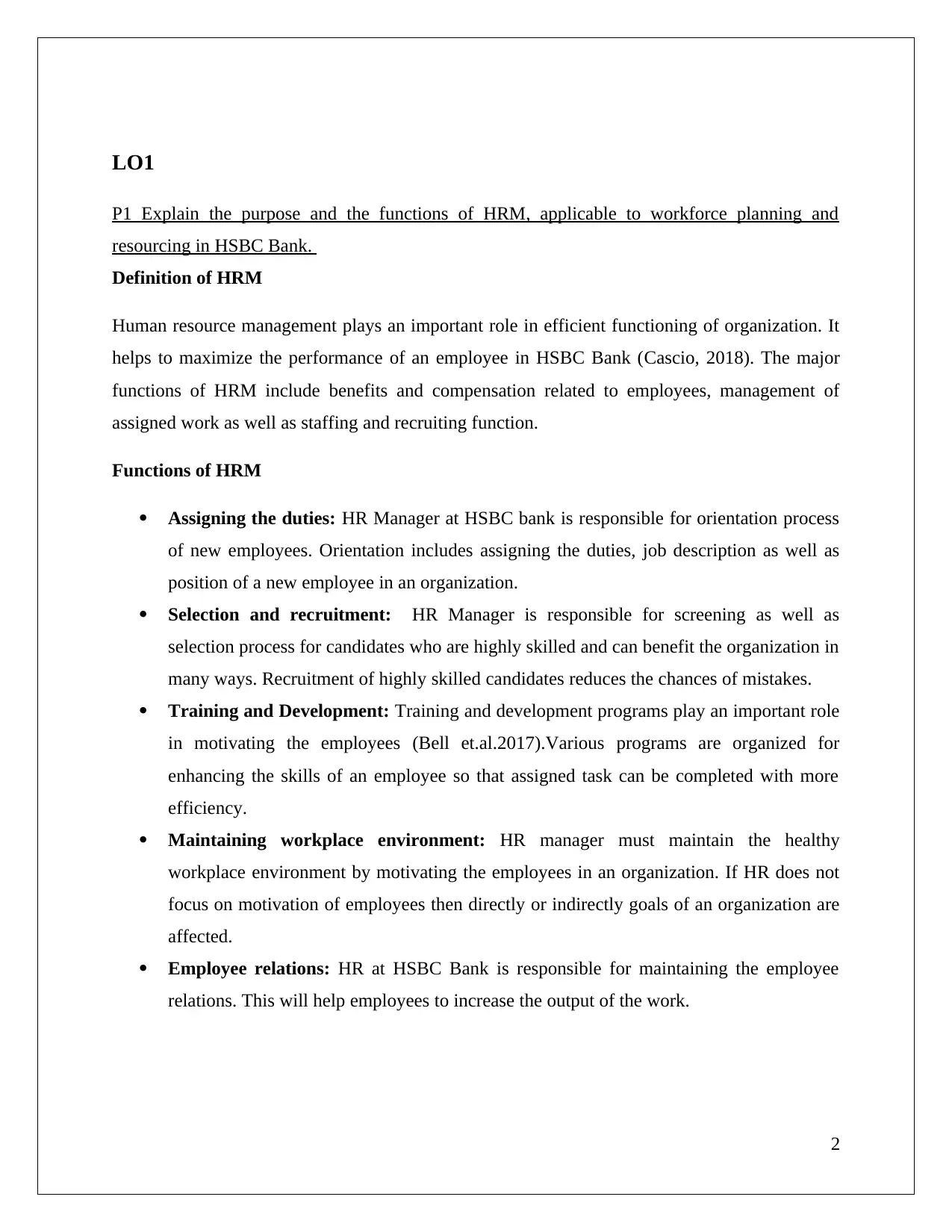
LO1
P1 Explain the purpose and the functions of HRM, applicable to workforce planning and
resourcing in HSBC Bank.
Definition of HRM
Human resource management plays an important role in efficient functioning of organization. It
helps to maximize the performance of an employee in HSBC Bank (Cascio, 2018). The major
functions of HRM include benefits and compensation related to employees, management of
assigned work as well as staffing and recruiting function.
Functions of HRM
Assigning the duties: HR Manager at HSBC bank is responsible for orientation process
of new employees. Orientation includes assigning the duties, job description as well as
position of a new employee in an organization.
Selection and recruitment: HR Manager is responsible for screening as well as
selection process for candidates who are highly skilled and can benefit the organization in
many ways. Recruitment of highly skilled candidates reduces the chances of mistakes.
Training and Development: Training and development programs play an important role
in motivating the employees (Bell et.al.2017).Various programs are organized for
enhancing the skills of an employee so that assigned task can be completed with more
efficiency.
Maintaining workplace environment: HR manager must maintain the healthy
workplace environment by motivating the employees in an organization. If HR does not
focus on motivation of employees then directly or indirectly goals of an organization are
affected.
Employee relations: HR at HSBC Bank is responsible for maintaining the employee
relations. This will help employees to increase the output of the work.
2
P1 Explain the purpose and the functions of HRM, applicable to workforce planning and
resourcing in HSBC Bank.
Definition of HRM
Human resource management plays an important role in efficient functioning of organization. It
helps to maximize the performance of an employee in HSBC Bank (Cascio, 2018). The major
functions of HRM include benefits and compensation related to employees, management of
assigned work as well as staffing and recruiting function.
Functions of HRM
Assigning the duties: HR Manager at HSBC bank is responsible for orientation process
of new employees. Orientation includes assigning the duties, job description as well as
position of a new employee in an organization.
Selection and recruitment: HR Manager is responsible for screening as well as
selection process for candidates who are highly skilled and can benefit the organization in
many ways. Recruitment of highly skilled candidates reduces the chances of mistakes.
Training and Development: Training and development programs play an important role
in motivating the employees (Bell et.al.2017).Various programs are organized for
enhancing the skills of an employee so that assigned task can be completed with more
efficiency.
Maintaining workplace environment: HR manager must maintain the healthy
workplace environment by motivating the employees in an organization. If HR does not
focus on motivation of employees then directly or indirectly goals of an organization are
affected.
Employee relations: HR at HSBC Bank is responsible for maintaining the employee
relations. This will help employees to increase the output of the work.
2
⊘ This is a preview!⊘
Do you want full access?
Subscribe today to unlock all pages.

Trusted by 1+ million students worldwide
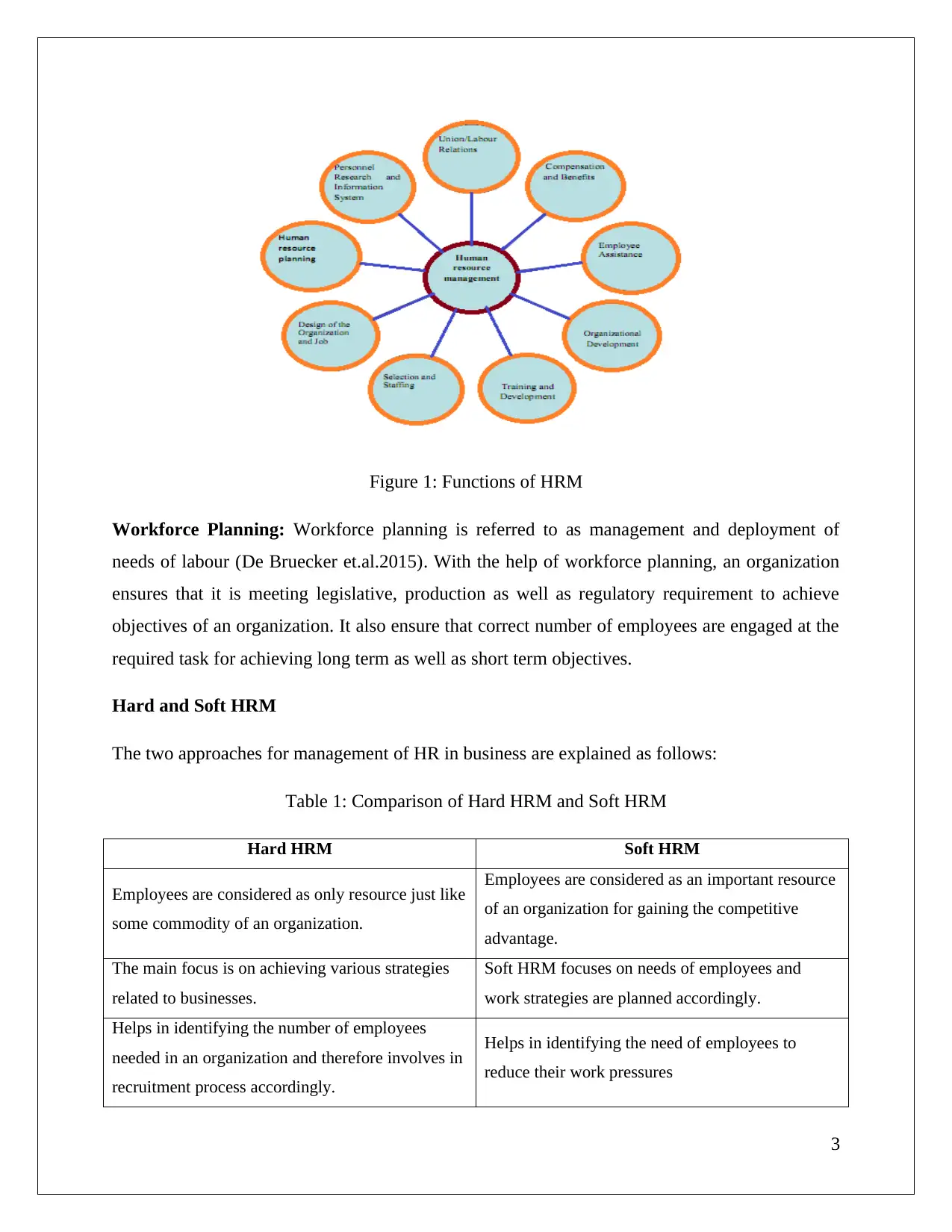
Figure 1: Functions of HRM
Workforce Planning: Workforce planning is referred to as management and deployment of
needs of labour (De Bruecker et.al.2015). With the help of workforce planning, an organization
ensures that it is meeting legislative, production as well as regulatory requirement to achieve
objectives of an organization. It also ensure that correct number of employees are engaged at the
required task for achieving long term as well as short term objectives.
Hard and Soft HRM
The two approaches for management of HR in business are explained as follows:
Table 1: Comparison of Hard HRM and Soft HRM
Hard HRM Soft HRM
Employees are considered as only resource just like
some commodity of an organization.
Employees are considered as an important resource
of an organization for gaining the competitive
advantage.
The main focus is on achieving various strategies
related to businesses.
Soft HRM focuses on needs of employees and
work strategies are planned accordingly.
Helps in identifying the number of employees
needed in an organization and therefore involves in
recruitment process accordingly.
Helps in identifying the need of employees to
reduce their work pressures
3
Workforce Planning: Workforce planning is referred to as management and deployment of
needs of labour (De Bruecker et.al.2015). With the help of workforce planning, an organization
ensures that it is meeting legislative, production as well as regulatory requirement to achieve
objectives of an organization. It also ensure that correct number of employees are engaged at the
required task for achieving long term as well as short term objectives.
Hard and Soft HRM
The two approaches for management of HR in business are explained as follows:
Table 1: Comparison of Hard HRM and Soft HRM
Hard HRM Soft HRM
Employees are considered as only resource just like
some commodity of an organization.
Employees are considered as an important resource
of an organization for gaining the competitive
advantage.
The main focus is on achieving various strategies
related to businesses.
Soft HRM focuses on needs of employees and
work strategies are planned accordingly.
Helps in identifying the number of employees
needed in an organization and therefore involves in
recruitment process accordingly.
Helps in identifying the need of employees to
reduce their work pressures
3
Paraphrase This Document
Need a fresh take? Get an instant paraphrase of this document with our AI Paraphraser
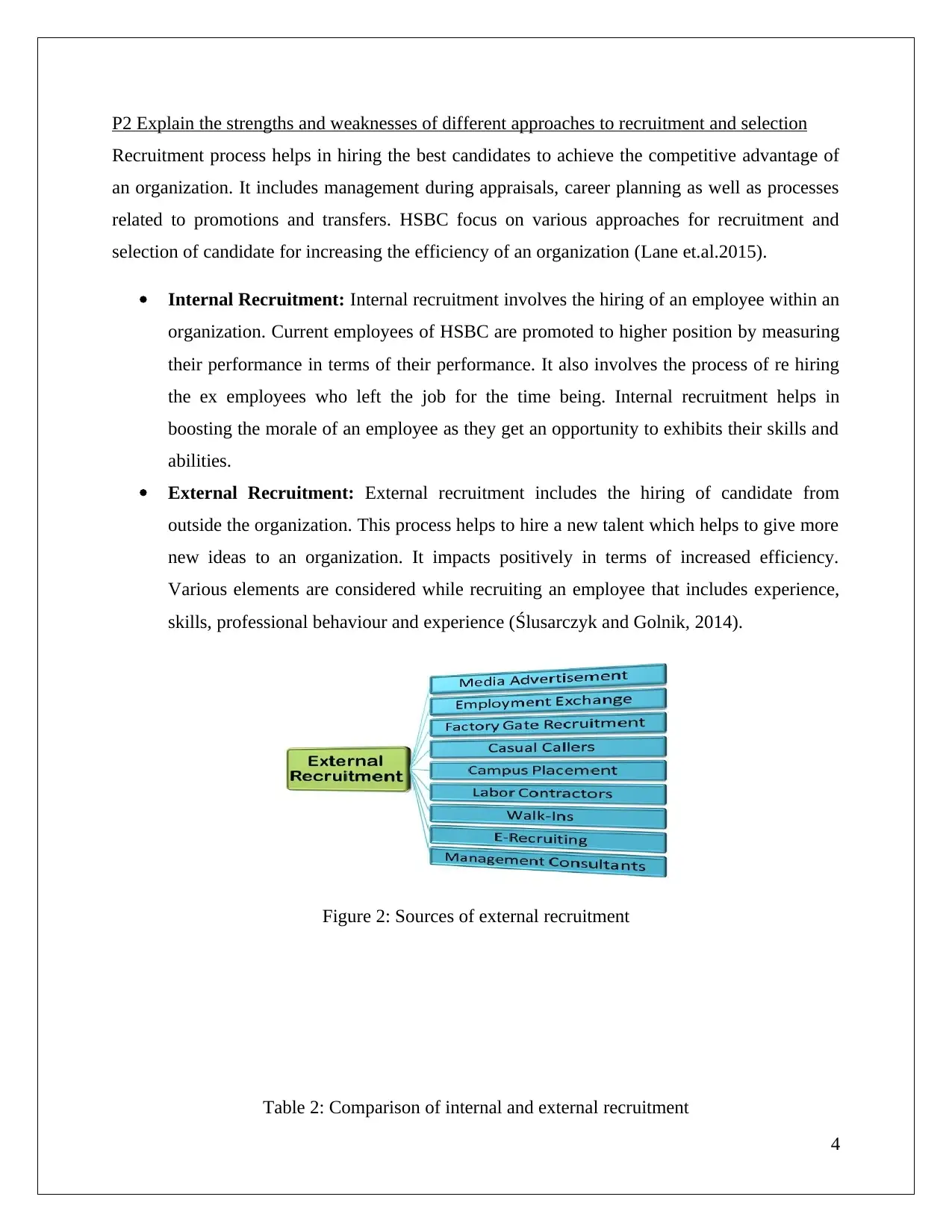
P2 Explain the strengths and weaknesses of different approaches to recruitment and selection
Recruitment process helps in hiring the best candidates to achieve the competitive advantage of
an organization. It includes management during appraisals, career planning as well as processes
related to promotions and transfers. HSBC focus on various approaches for recruitment and
selection of candidate for increasing the efficiency of an organization (Lane et.al.2015).
Internal Recruitment: Internal recruitment involves the hiring of an employee within an
organization. Current employees of HSBC are promoted to higher position by measuring
their performance in terms of their performance. It also involves the process of re hiring
the ex employees who left the job for the time being. Internal recruitment helps in
boosting the morale of an employee as they get an opportunity to exhibits their skills and
abilities.
External Recruitment: External recruitment includes the hiring of candidate from
outside the organization. This process helps to hire a new talent which helps to give more
new ideas to an organization. It impacts positively in terms of increased efficiency.
Various elements are considered while recruiting an employee that includes experience,
skills, professional behaviour and experience (Ślusarczyk and Golnik, 2014).
Figure 2: Sources of external recruitment
Table 2: Comparison of internal and external recruitment
4
Recruitment process helps in hiring the best candidates to achieve the competitive advantage of
an organization. It includes management during appraisals, career planning as well as processes
related to promotions and transfers. HSBC focus on various approaches for recruitment and
selection of candidate for increasing the efficiency of an organization (Lane et.al.2015).
Internal Recruitment: Internal recruitment involves the hiring of an employee within an
organization. Current employees of HSBC are promoted to higher position by measuring
their performance in terms of their performance. It also involves the process of re hiring
the ex employees who left the job for the time being. Internal recruitment helps in
boosting the morale of an employee as they get an opportunity to exhibits their skills and
abilities.
External Recruitment: External recruitment includes the hiring of candidate from
outside the organization. This process helps to hire a new talent which helps to give more
new ideas to an organization. It impacts positively in terms of increased efficiency.
Various elements are considered while recruiting an employee that includes experience,
skills, professional behaviour and experience (Ślusarczyk and Golnik, 2014).
Figure 2: Sources of external recruitment
Table 2: Comparison of internal and external recruitment
4
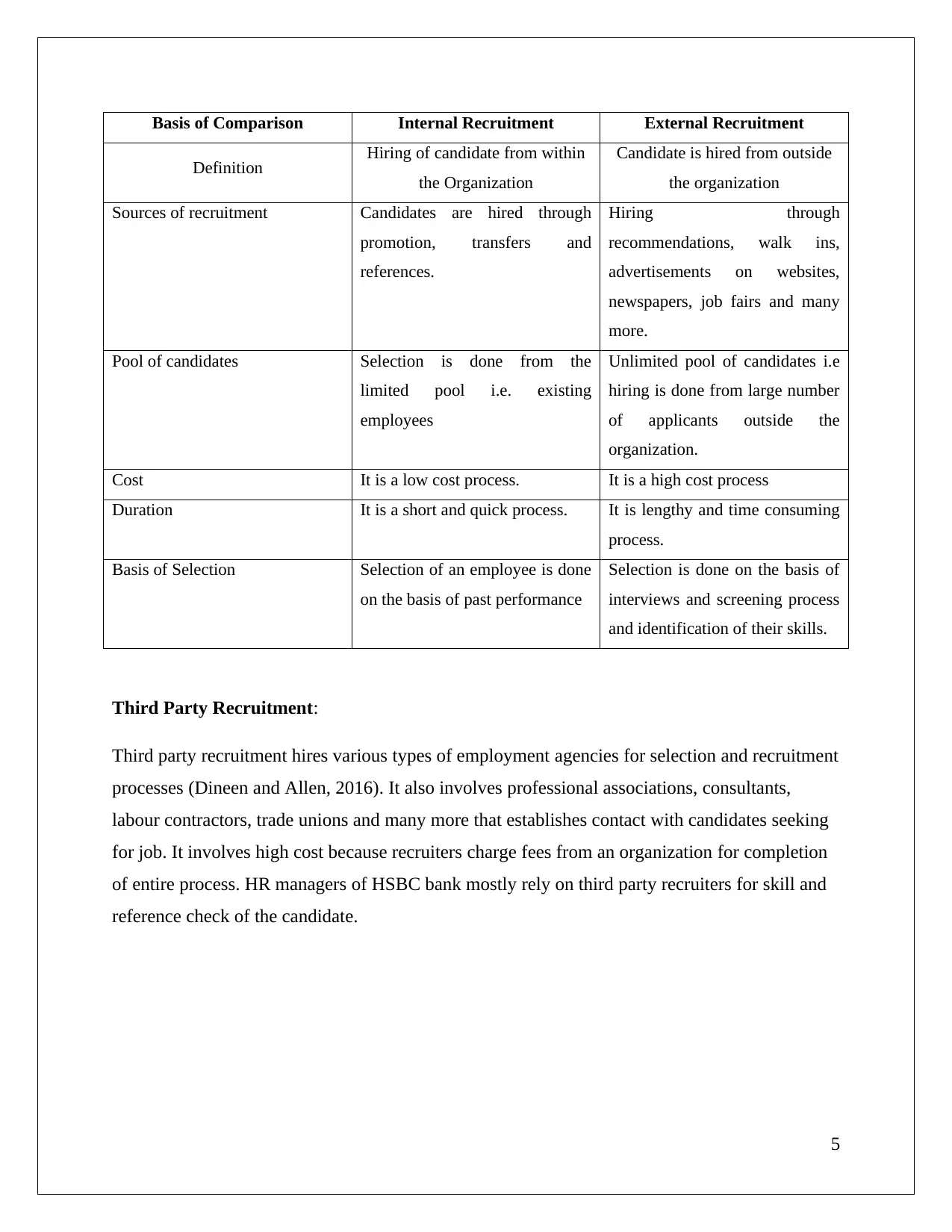
Basis of Comparison Internal Recruitment External Recruitment
Definition Hiring of candidate from within
the Organization
Candidate is hired from outside
the organization
Sources of recruitment Candidates are hired through
promotion, transfers and
references.
Hiring through
recommendations, walk ins,
advertisements on websites,
newspapers, job fairs and many
more.
Pool of candidates Selection is done from the
limited pool i.e. existing
employees
Unlimited pool of candidates i.e
hiring is done from large number
of applicants outside the
organization.
Cost It is a low cost process. It is a high cost process
Duration It is a short and quick process. It is lengthy and time consuming
process.
Basis of Selection Selection of an employee is done
on the basis of past performance
Selection is done on the basis of
interviews and screening process
and identification of their skills.
Third Party Recruitment:
Third party recruitment hires various types of employment agencies for selection and recruitment
processes (Dineen and Allen, 2016). It also involves professional associations, consultants,
labour contractors, trade unions and many more that establishes contact with candidates seeking
for job. It involves high cost because recruiters charge fees from an organization for completion
of entire process. HR managers of HSBC bank mostly rely on third party recruiters for skill and
reference check of the candidate.
5
Definition Hiring of candidate from within
the Organization
Candidate is hired from outside
the organization
Sources of recruitment Candidates are hired through
promotion, transfers and
references.
Hiring through
recommendations, walk ins,
advertisements on websites,
newspapers, job fairs and many
more.
Pool of candidates Selection is done from the
limited pool i.e. existing
employees
Unlimited pool of candidates i.e
hiring is done from large number
of applicants outside the
organization.
Cost It is a low cost process. It is a high cost process
Duration It is a short and quick process. It is lengthy and time consuming
process.
Basis of Selection Selection of an employee is done
on the basis of past performance
Selection is done on the basis of
interviews and screening process
and identification of their skills.
Third Party Recruitment:
Third party recruitment hires various types of employment agencies for selection and recruitment
processes (Dineen and Allen, 2016). It also involves professional associations, consultants,
labour contractors, trade unions and many more that establishes contact with candidates seeking
for job. It involves high cost because recruiters charge fees from an organization for completion
of entire process. HR managers of HSBC bank mostly rely on third party recruiters for skill and
reference check of the candidate.
5
⊘ This is a preview!⊘
Do you want full access?
Subscribe today to unlock all pages.

Trusted by 1+ million students worldwide
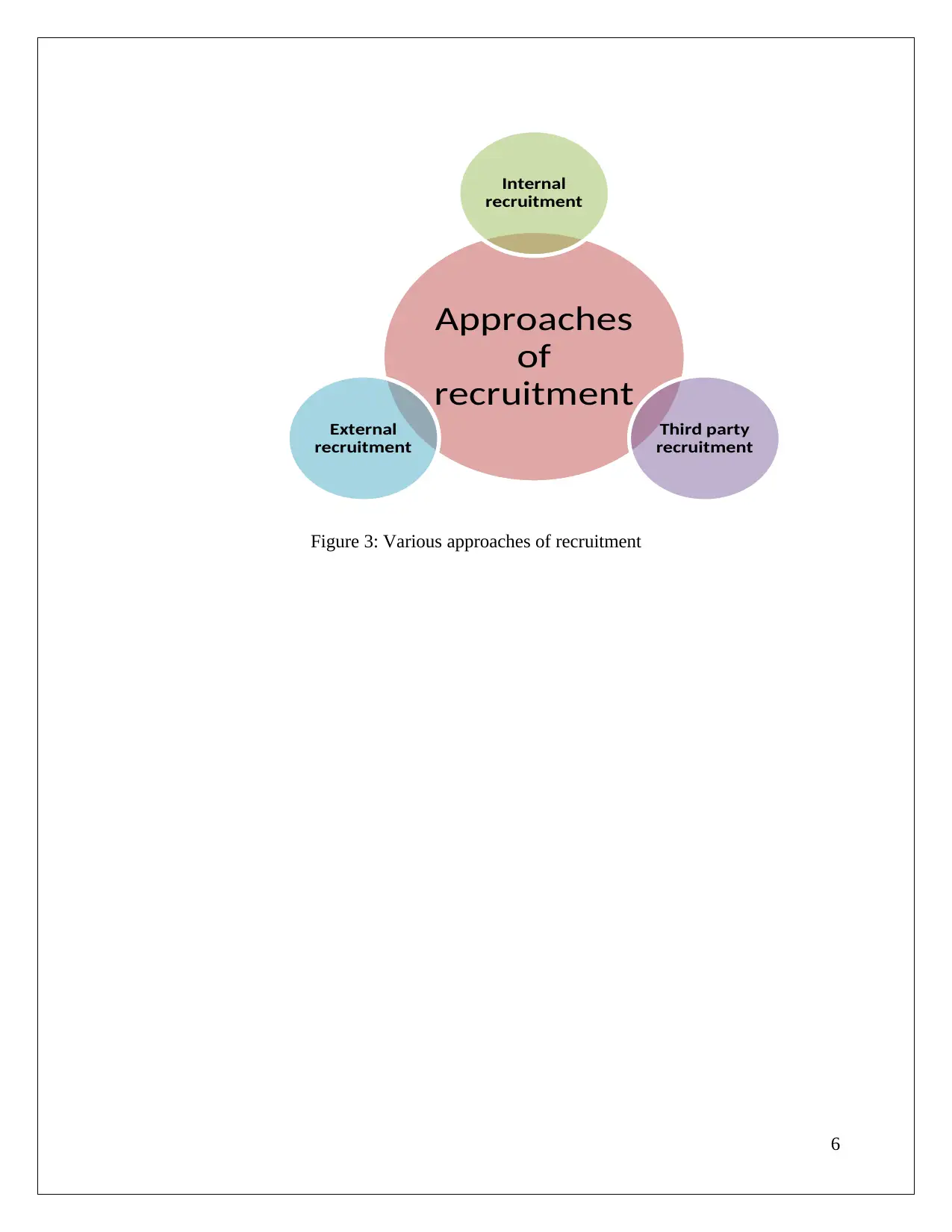
Figure 3: Various approaches of recruitment
6
Approaches
of
recruitment
Internal
recruitment
Third party
recruitment
External
recruitment
6
Approaches
of
recruitment
Internal
recruitment
Third party
recruitment
External
recruitment
Paraphrase This Document
Need a fresh take? Get an instant paraphrase of this document with our AI Paraphraser
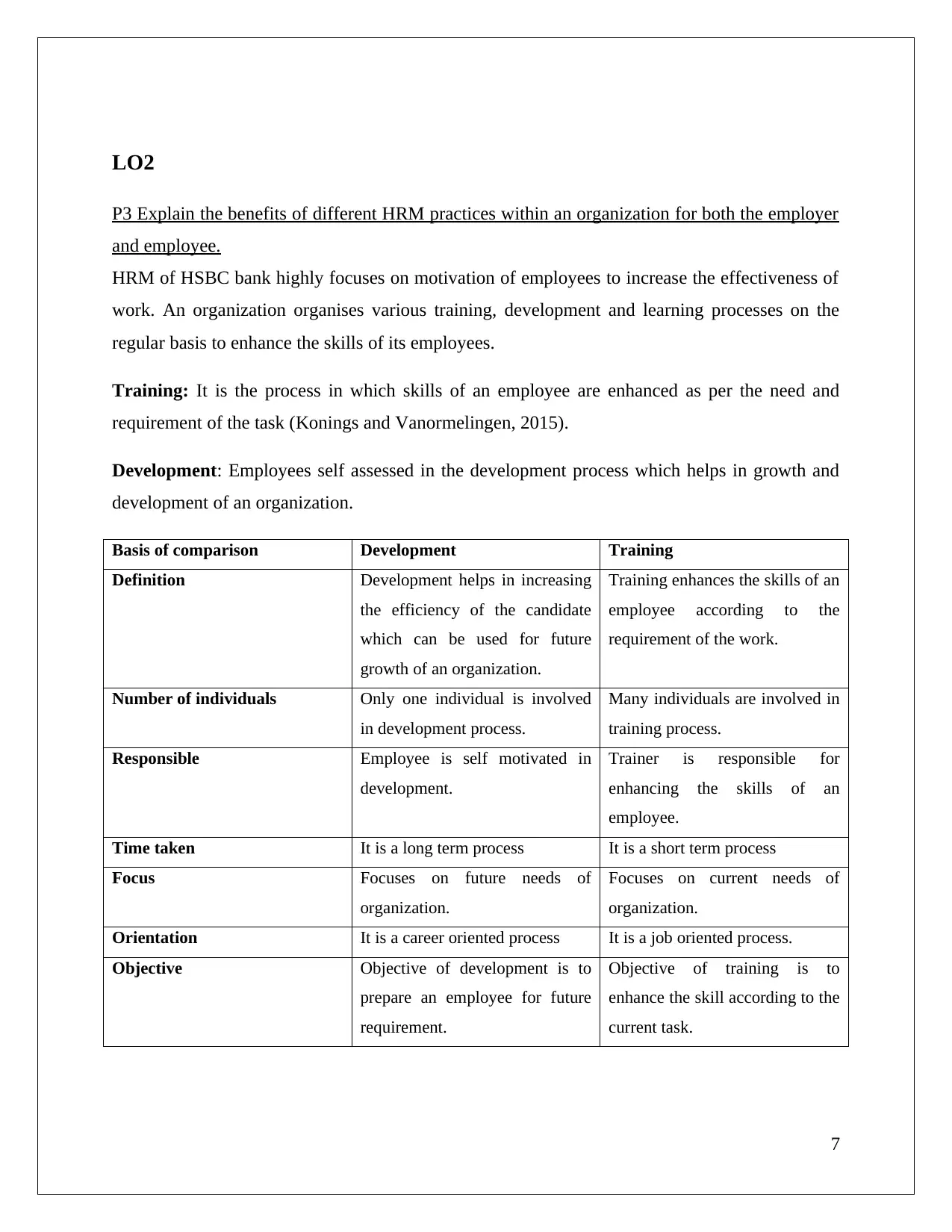
LO2
P3 Explain the benefits of different HRM practices within an organization for both the employer
and employee.
HRM of HSBC bank highly focuses on motivation of employees to increase the effectiveness of
work. An organization organises various training, development and learning processes on the
regular basis to enhance the skills of its employees.
Training: It is the process in which skills of an employee are enhanced as per the need and
requirement of the task (Konings and Vanormelingen, 2015).
Development: Employees self assessed in the development process which helps in growth and
development of an organization.
Basis of comparison Development Training
Definition Development helps in increasing
the efficiency of the candidate
which can be used for future
growth of an organization.
Training enhances the skills of an
employee according to the
requirement of the work.
Number of individuals Only one individual is involved
in development process.
Many individuals are involved in
training process.
Responsible Employee is self motivated in
development.
Trainer is responsible for
enhancing the skills of an
employee.
Time taken It is a long term process It is a short term process
Focus Focuses on future needs of
organization.
Focuses on current needs of
organization.
Orientation It is a career oriented process It is a job oriented process.
Objective Objective of development is to
prepare an employee for future
requirement.
Objective of training is to
enhance the skill according to the
current task.
7
P3 Explain the benefits of different HRM practices within an organization for both the employer
and employee.
HRM of HSBC bank highly focuses on motivation of employees to increase the effectiveness of
work. An organization organises various training, development and learning processes on the
regular basis to enhance the skills of its employees.
Training: It is the process in which skills of an employee are enhanced as per the need and
requirement of the task (Konings and Vanormelingen, 2015).
Development: Employees self assessed in the development process which helps in growth and
development of an organization.
Basis of comparison Development Training
Definition Development helps in increasing
the efficiency of the candidate
which can be used for future
growth of an organization.
Training enhances the skills of an
employee according to the
requirement of the work.
Number of individuals Only one individual is involved
in development process.
Many individuals are involved in
training process.
Responsible Employee is self motivated in
development.
Trainer is responsible for
enhancing the skills of an
employee.
Time taken It is a long term process It is a short term process
Focus Focuses on future needs of
organization.
Focuses on current needs of
organization.
Orientation It is a career oriented process It is a job oriented process.
Objective Objective of development is to
prepare an employee for future
requirement.
Objective of training is to
enhance the skill according to the
current task.
7
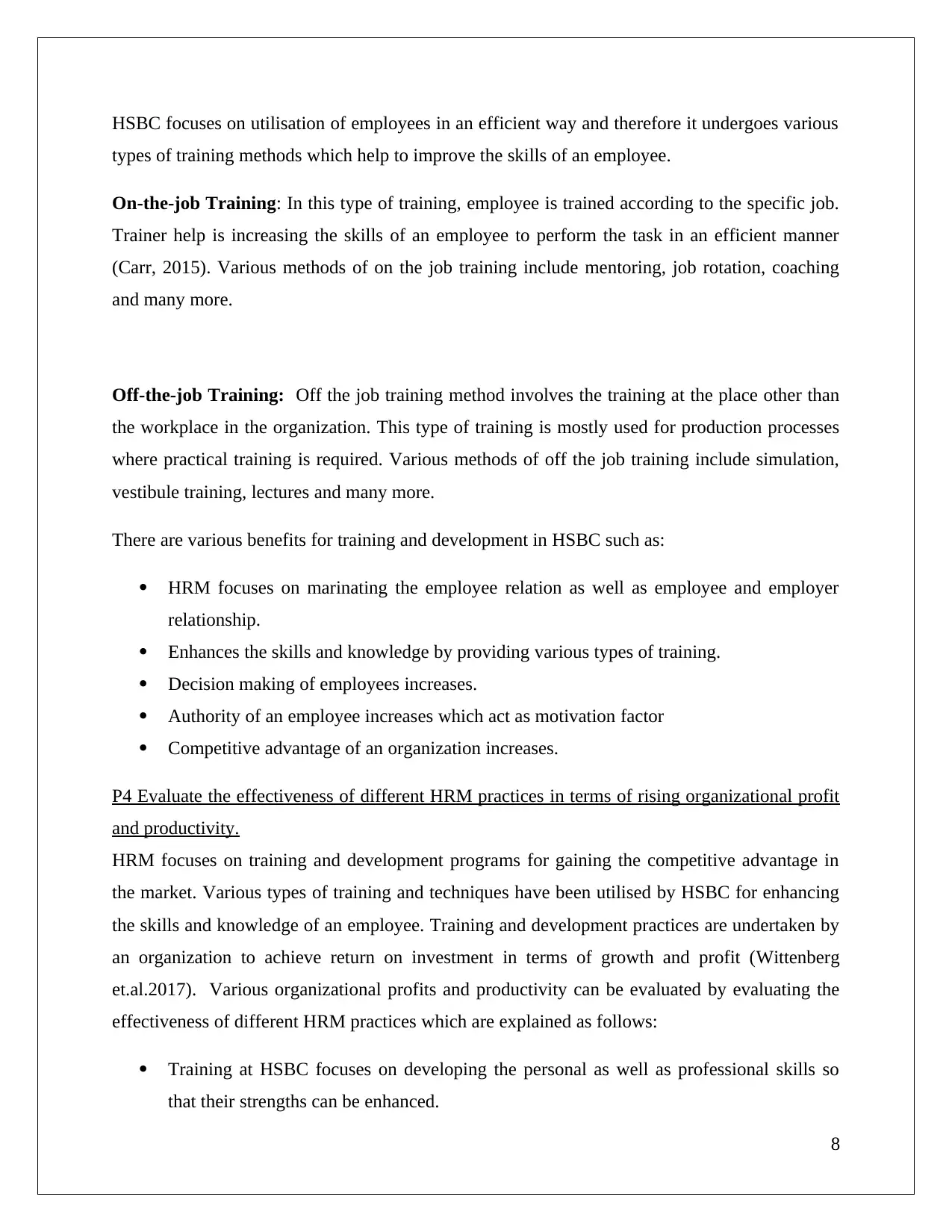
HSBC focuses on utilisation of employees in an efficient way and therefore it undergoes various
types of training methods which help to improve the skills of an employee.
On-the-job Training: In this type of training, employee is trained according to the specific job.
Trainer help is increasing the skills of an employee to perform the task in an efficient manner
(Carr, 2015). Various methods of on the job training include mentoring, job rotation, coaching
and many more.
Off-the-job Training: Off the job training method involves the training at the place other than
the workplace in the organization. This type of training is mostly used for production processes
where practical training is required. Various methods of off the job training include simulation,
vestibule training, lectures and many more.
There are various benefits for training and development in HSBC such as:
HRM focuses on marinating the employee relation as well as employee and employer
relationship.
Enhances the skills and knowledge by providing various types of training.
Decision making of employees increases.
Authority of an employee increases which act as motivation factor
Competitive advantage of an organization increases.
P4 Evaluate the effectiveness of different HRM practices in terms of rising organizational profit
and productivity.
HRM focuses on training and development programs for gaining the competitive advantage in
the market. Various types of training and techniques have been utilised by HSBC for enhancing
the skills and knowledge of an employee. Training and development practices are undertaken by
an organization to achieve return on investment in terms of growth and profit (Wittenberg
et.al.2017). Various organizational profits and productivity can be evaluated by evaluating the
effectiveness of different HRM practices which are explained as follows:
Training at HSBC focuses on developing the personal as well as professional skills so
that their strengths can be enhanced.
8
types of training methods which help to improve the skills of an employee.
On-the-job Training: In this type of training, employee is trained according to the specific job.
Trainer help is increasing the skills of an employee to perform the task in an efficient manner
(Carr, 2015). Various methods of on the job training include mentoring, job rotation, coaching
and many more.
Off-the-job Training: Off the job training method involves the training at the place other than
the workplace in the organization. This type of training is mostly used for production processes
where practical training is required. Various methods of off the job training include simulation,
vestibule training, lectures and many more.
There are various benefits for training and development in HSBC such as:
HRM focuses on marinating the employee relation as well as employee and employer
relationship.
Enhances the skills and knowledge by providing various types of training.
Decision making of employees increases.
Authority of an employee increases which act as motivation factor
Competitive advantage of an organization increases.
P4 Evaluate the effectiveness of different HRM practices in terms of rising organizational profit
and productivity.
HRM focuses on training and development programs for gaining the competitive advantage in
the market. Various types of training and techniques have been utilised by HSBC for enhancing
the skills and knowledge of an employee. Training and development practices are undertaken by
an organization to achieve return on investment in terms of growth and profit (Wittenberg
et.al.2017). Various organizational profits and productivity can be evaluated by evaluating the
effectiveness of different HRM practices which are explained as follows:
Training at HSBC focuses on developing the personal as well as professional skills so
that their strengths can be enhanced.
8
⊘ This is a preview!⊘
Do you want full access?
Subscribe today to unlock all pages.

Trusted by 1+ million students worldwide
1 out of 21
Related Documents
Your All-in-One AI-Powered Toolkit for Academic Success.
+13062052269
info@desklib.com
Available 24*7 on WhatsApp / Email
![[object Object]](/_next/static/media/star-bottom.7253800d.svg)
Unlock your academic potential
Copyright © 2020–2025 A2Z Services. All Rights Reserved. Developed and managed by ZUCOL.




